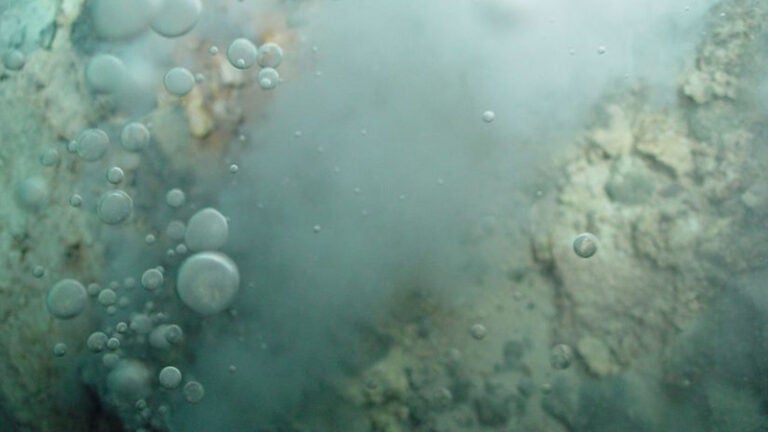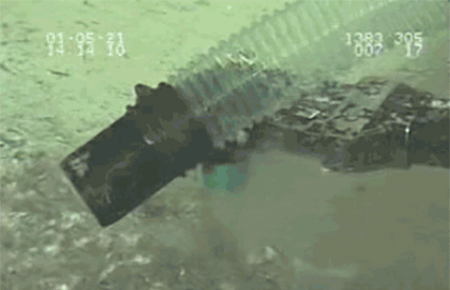
Undersea gases once helped superheat our planet — here’s how
The world’s oceans could harbor an unpleasant surprise for global warming, based on new research that shows how naturally occurring carbon gases trapped in reservoirs atop the seafloor escaped to superheat the planet in prehistory.
Scientists say events that began on the ocean bottom thousands of years ago so disrupted the Earth’s atmosphere that it melted away the ice age. Those new findings challenge a long-standing paradigm that ocean water alone regulated carbon dioxide in the atmosphere during glacial cycles. Instead, the study shows geologic processes can dramatically upset the carbon cycle and cause global change.
For today’s world, the findings could portend an ominous development: The undersea carbon reservoirs released greenhouse gas to the atmosphere as oceans warmed, and today the ocean is heating up again due to manmade global warming.
If undersea carbon reservoirs are upset again, they would emit a huge new source of greenhouse gases, exacerbating climate change. Temperature increases in the ocean are on pace to reach that tipping point by the end of the century. For example, a big carbon reservoir beneath the western Pacific near Taiwan is already within a few degrees Celsius of destabilizing.
A wild-card threat
The phenomenon is a threat unaccounted for in climate model projections. Undersea carbon dioxide reservoirs are relatively recent discoveries and their characteristics and history are only beginning to be understood.
Those findings come from a new research paper produced by an international team of Earth scientists led by USC Dornsife College of Letters, Arts and Sciences and published in January in the journal Environmental Research Letters.
“We’re using the past as a way to anticipate the future,” said Lowell Stott, professor of Earth sciences at USC Dornsife and lead author of the study. “We know there are vast reservoirs of carbon gas at the bottom of the oceans. We know when they were disrupted during the Pleistocene it warmed the planet.
“We have to know if these carbon reservoirs could be destabilized again. It’s a wild card for which we need to account.”
At issue are expanses of carbon dioxide and methane accumulating underwater and scattered across the seafloor. They form as volcanic activity releases heat and gases that can congeal into liquid and solid hydrates, which are compounds stuck together in an icy slurry that encapsulates the reservoirs.
Vulnerable to ocean warming
These undersea carbon reservoirs largely stay put unless disturbed, but the study shows the natural reservoirs are vulnerable in a warming ocean and provides proof the Earth’s climate has been affected by rapid release of geologic carbon.
The scientists say it occurred in the distant past when the Earth was much warmer, and it’s happened more recently — about 17,000 years ago at the end of the Pleistocene epoch when glaciers advanced and receded, which is the focus on the study. Warming was evident due to changes in atmospheric greenhouse gas concentrations, based on ice cores, marine and continental records.
But how did that happen? What forced such dramatic change in the first place? Scientists have been searching for that answer for 40 years, with focus on oceans because they’re a giant carbon sink and play a central role in carbon dioxide variations.
They soon realized that processes that regulate ocean carbon operated too slowly to account for the surge in atmospheric greenhouse gases that led to warming that ended the ice age. So, scientists around the world began examining the role of Earth’s hydrothermal systems and their impact on deep-ocean carbon to see how it affected the atmosphere.
The current study focused on the Eastern Equatorial Pacific (EEP) hundreds of miles off the coast of Ecuador. The EEP is a primary conduit through which the ocean releases carbon to the atmosphere.
Their data show that there were major releases of naturally occurring carbon from the EEP, which contributed to dramatic change in Earth’s temperature as the ice age was ending.

A deep-sea reservoir near Taiwan spews carbon dioxide when its slurry-like hydrate cap ruptures. (Video: Courtesy of The National Academy of Sciences of the USA.)
More reservoirs revealed
Elsewhere around the world, more and more deep-ocean carbon reservoirs are being discovered. They mostly occur near hydrothermal vents, of which scores have been identified so far, especially in the Pacific, Atlantic and Indian oceans. They occur where the Earth’s crust spreads or collides, creating ideal conditions for the formation of deep-sea carbon dioxide reservoirs. Only about one-third of the ocean’s volcanic regions have been surveyed.
One such reservoir of undersea carbon dioxide was discovered off the coast of Taiwan. Similar discoveries of carbon gas reservoirs have been made off the coast of Okinawa, in the Aegean Sea, in the Gulf of California and off Canada’s west coast.
“The grand challenge is we don’t have estimates of the size of these or which ones are particularly vulnerable to destabilization,” Stott said. “It’s something that needs to be determined.”
In many cases, the carbon reservoirs are bottled up by their hydrate caps. But those covers are sensitive to temperature changes. As oceans warm, the caps can melt, a development the paper warns would lead to a double wallop for climate change — a new source of geologic carbon in addition to the manmade greenhouse gases.
The study comes with some caveats. Much of the ocean floor is unexplored, so scientists don’t know the full extent of the carbon dioxide reservoirs. There is no inventory of greenhouse gases from these geologic sources. And, ocean warming is not uniform, making it difficult to predict when and where the undersea carbon reservoirs will be affected. It would take much more study to answer those questions.
Nonetheless, the study makes clear the undersea carbon reservoirs are at risk.
“This study shows that we’ve been missing a critical component of the marine carbon budget,” Stott said. “It shows these geologic reservoirs can release large amounts of carbon from the oceans. Our paper makes the case that this process has happened before and it could happen again.”
About the study
Additional study authors are Kathleen M. Harazin of the Australian National University and Nadine B. Quintana Krupinski of Lund University, Sweden. U.S. funding for the study comes from a National Science Foundation Marine Geology and Geophysics Grant (1558990).